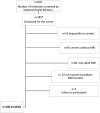Children and neonates anesthesia in magnetic resonance environment in Italy: an active call survey
- PMID: 36056321
- PMCID: PMC9438255
- DOI: 10.1186/s12871-022-01821-3
Children and neonates anesthesia in magnetic resonance environment in Italy: an active call survey
Abstract
Background: Pediatric anesthesia care in the Magnetic Resonance Imaging is a challenge for clinicians. The recent debate about the role of anesthetic agent on neural development, encouraged an evaluation of their actual activity in this environment. In this active call survey, the authors sought to delineate the Italian situation regarding national centers, staff involved, monitoring tools available and sedation techniques.
Methods: A complete sample of all national centers performing almost a pediatric discharge in the 2014 was obtained from Health Ministry registers. All Institutions were contacted for a prospective phone investigation and a three-section survey was fill out with the Physician in charge. A descriptive and exploratory analyzes about the organization setting of the Centers were performed.
Results: Among 876 Institution screened, only 106 (37%) met minimal criteria for inclusion. Children are managed by anesthesiologists in the 95% of cases, while neonates in the 54%. A dedicated nurse is present in 74% of centers. While a pulse oximetry is present in 100% of centers, the rate of prevalence of other monitoring is lower. A specific MRI-compatible ventilator is available in the 95% of Centers, but many tools are not equally homogenously distributed. Pharmacological approach is preferred in pediatric age (98%), but its use for newborns is reduced to 43%.
Conclusions: We found significant heterogeneity in the daily clinical practice of sedation in MRI. Our results could be a starting point to evaluate the further evolution of approach to children and neonates in magnetic resonance setting.
Trial registration: ClinicalTrials.gov identifier: NCT04775641.
Keywords: Anesthesia; Children; Magnetic Resonance; Monitoring; Neonates; Sedation.
© 2022. The Author(s).
Conflict of interest statement
The authors declare no competing interests.
Figures
References
Publication types
MeSH terms
Associated data
LinkOut - more resources
Full Text Sources
Medical
Miscellaneous



